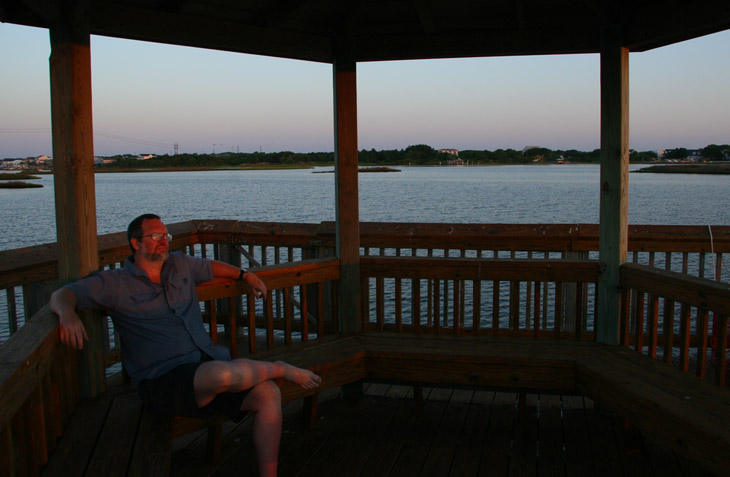
Let’s see, where to begin, where to begin. As mentioned in the previous post, we just spent a week out at the beach – notice how it’s never “a beach” but a singular title, like there’s just one beach? I mean, there’s like 367 beaches in North Carolina alone. But anyway, we were at that one, the one you’re all familiar with. At least if you’re familiar with North Topsail Beach, one of the many barrier islands but not actually the Outer Banks. This wouldn’t have been my first choice, because I believed it to be a bit too developed, but actually it wasn’t bad at all. And we had extraordinary luck, in many ways, while there; the weather was great, all sunny days, not too hot nor the least bit cold, save for the first evening when it got a bit chilly. The place we rented was just a hair removed from the beach proper, being across the road from the ‘beachfront’ houses, which meant not quite as much view of the ocean and an arduous 45-second hike to the sand, but the back fed directly onto the sound, a placid tidal marsh area well removed from the inland waterway, so you know I was in my element. And of course, I have a shitload of pics to put up, so some of the upcoming posts may be notably lacking in verbiage. I know, the thought pains me as much as it does you, but sometimes sacrifices have to be made.
And here’s another sad note: There are almost no insect photos to be found from this past week. But, curiously, that does not extend to arthropod photos, of which I have many. I’ll let you dwell on that as I move on.
The area I live within isn’t the best for scenic and landscape photos, so I take advantage of the possibilities when I travel, and of course sunrise and sunset shots are virtually a necessity – I think there was just one day when I wasn’t up at sunrise.

So, a quick bit of advice, which I’ve offered before: if you’re shooting sunrise or sunset, bracket your exposures. This means shooting purposefully over- and under-exposed, several frames at different settings. If you’re not sure how to do this, I have a page that explains a bit about it, though you might have to check your camera manual to know exactly how it works on your own camera. Or, if you’re close to the Triangle area of central NC, I give personal lessons. It’s also not a bad idea to have the contrast and saturation boosted a bit, to make the colors vivid. White balance should be set to sunlight – do not use auto white balance (AWB), because it may alter those lovely golden hues that come along at these times. And finally, be warned that on clear days, the light may be high contrast not too long after sunrise, or for a while leading up to sunset; the thick atmosphere near the horizon will soften the light, but when the sun is away from the horizon this softening effect will fade and you may start getting the harsh highlights and shadows from high-contrast light, whereupon you might want to reduce contrast and saturation settings to manage the conditions better. In other words, your camera settings should be the opposite of the light conditions, to keep the images manageable. For the surf-and-sunrise shot above, I had the saturation and contrast boosted (not very much – subtlety is important) and the exposure set 1 full stop under normal.
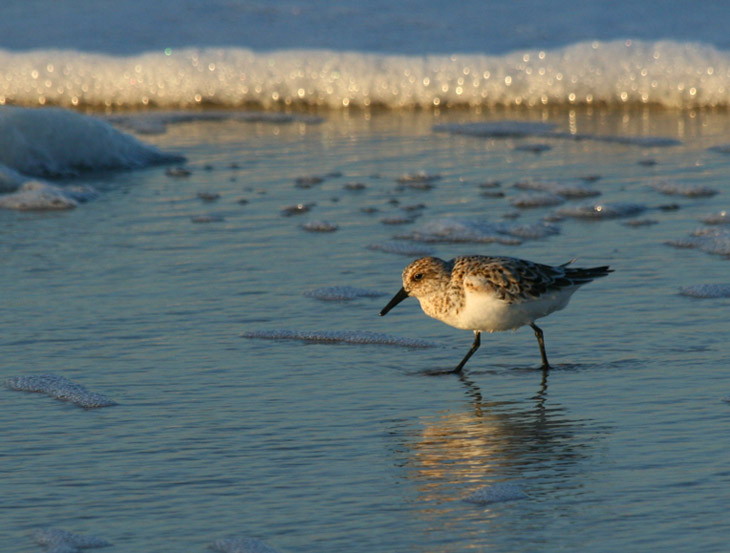
For reasons unknown, the birds were pretty thin while we were there, and it kept me from getting too many photos of them. Even the sanderlings seen here (sandpiper isn’t the right term, though they’re related, but Calidris alba for the scientific name) were few in number, and only the occasional flight of pelicans could be found, so I didn’t get the desired opportunities for fartsy shots of them. Maybe it was simply the time of year, maybe it was the beach itself, oriented more east-west than north-south as you’d expect, since pelicans often use the prevailing winds and the minor updrafts kicking over the wave crests to glide without expending the energy to flap. I’m skeptical of this though, since we had a near constant breeze through the rental place that negated any need of air-conditioning, which was great! Well, okay, it had one particular negative point, in that sleeping with the sliding glass doors open meant the Carolina wren that perched on the deck railing each and every morning to vent its territorial claims, at first light, made it hard to sleep past that time, something that The Girlfriend noticed more than I since, as I said, I was usually up at that time anyway.
I was mentally prepared for a lot of things such as high traffic or crowded areas, noisy neighbors, expensive restaurants, and all that jazz, none of which appeared in the slightest – even our unit of three condos was otherwise empty for most of the week, and quietly occupied otherwise. But there was one thing I hadn’t anticipated at all, and that was the military presence. There was a US Marine base not too far northwest of us, and Monday through Thursday they were showing significant activity, which meant that the distant rattle of helicopters was near-constant, as well as the occasional thump of artillery or some such related explosives. A few times a day, the helos would pass close by, and since I’m a helicopter enthusiast (I actually have a trivial amount of time logged at the controls,) this means you get the list: primarily the CH-53 Super Stallions, but also some V-22 Osprey tiltrotors, and occasionally an AH-1W Super Cobra and UH-1Y Super Huey (or Venom) seen below. Yeah, this was the 170-500mm lens, but they passed pretty close sometimes.
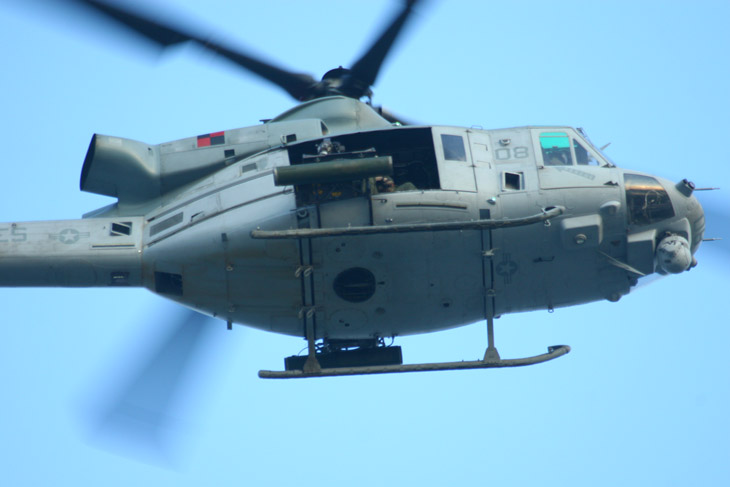
Tuesday and Wednesday I think (the days just kind of ran together, which was fine, because who needed to know?) a deeper and more resounding set of thumps joined the festivities, ones loud enough to actually rattle the building: a guided missile destroyer, the USS Arleigh Burke I believe, was offshore firing its 127mm (5 inch) deck gun, and even at better than 20 km off by my estimate, it was impressive. Now, I still found all of this less annoying than leaf-blowers or country/western music, but The Girlfriend was more affected.
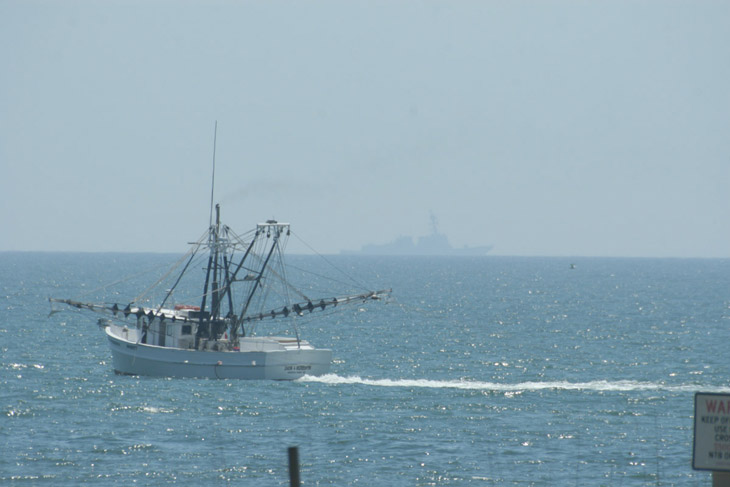
This is full-frame with the 500mm, by the way, and what I’m referring to is that ghost in the background, specifically that little nub sticking up from the front deck, which is the 127mm gun. The sign at right foreground is on the dune at the beach access, better than a hundred meters from my shooting position.
Knowing what the area was going to be like (geographically, I mean,) I had finally gotten my hands on a one-person kayak right before the trip. Like I said, the property backed right onto the sound, and even had a deck and gazebo sitting on the water (seen in the opening shot,) so perfect, right? Well, not perfect – the gazebo had a tiny dock of sorts, but much higher off the water than really worked for the low draft of a kayak, and the water’s edges were all thickly shrouded in dense reeds. After a bit of scouting, I determined I could gain an access of sorts by going alongside the deck a ways and then using a little inlet channel, knowing the kayak only needed a few inches of water to float out in, and I was cool with wading through a little muck to get launched. The Girlfriend was down there watching, and unfortunately didn’t get her camera out for all the fun, because it would have been entertaining, at least. What I considered “a little muck” was a deep layer of oozing mud, which I sank into by about 30cm, so badly I could barely move. I had thoughtfully used the old, beat-up wading sandals, which was good, because I damn near left them behind – I eventually just pulled out one foot, leaving the sandal buried, then jammed my arm down and slowly retrieved the footwear with a lot of wiggling and cursing. After far too much playing around, I got the kayak out, and myself into it, then spent a lot of effort pushing it through the mud to deeper water – turns out it was sitting lower than expected and grounding itself on the ersatz “bottom.” Once I got a little actual flotation going, it then began to catch on the oysters attached to every available reed stem, and I still had to work it past them. Eventually, I hit open water, and could start proper paddling.
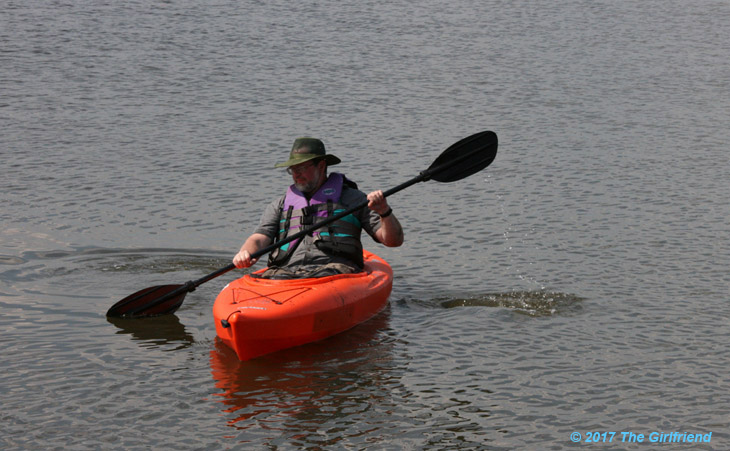
Most of the mud has been rinsed off the kayak by the time of this photo, and you can’t see my caked legs or the blobs of the sandals sitting within. I only did a short excursion to get the feel of the kayak, and also because I’d expended a lot of energy just getting the damn thing out to open water. I found that most of the sound was ridiculously shallow, easily able to be waded if it weren’t for the mud, and oysters were everywhere, not to mention how often I spooked fish when going up one of the many channels between tussock islands. When it came time to return, I opted to get out at the gazebo dock, which presented a whole new challenge since, like I said, it was too high for those kind of shenanigans. Eventually, and with help, I got back to dry land, but it meant that was the only time the kayak went out, and without the camera at that. There are plenty of places to use it around here, so you’ll see more evidence of it eventually, once I feel comfortable taking a camera (enclosed in waterproof bags during travel) out with me.
The gazebo itself hosted a barn swallow nest under the roof, and they were often wheeling around us when we were out there, returning to the nest when we held still enough or moved far enough from it. But this allowed me to do a couple of close pics while they posed.
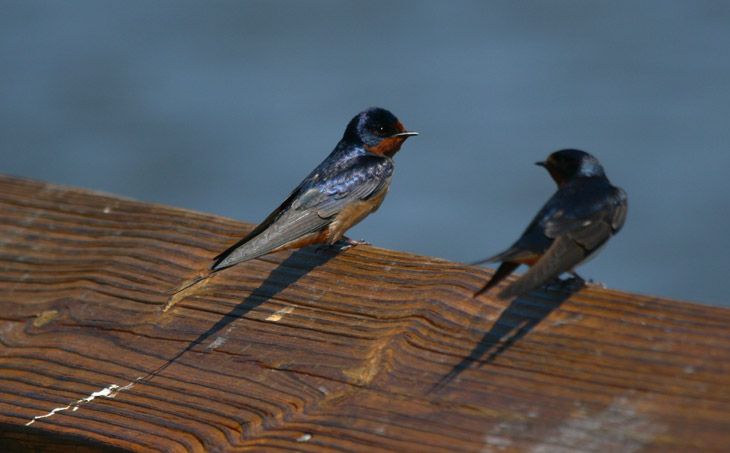
Barn swallows (Hirundo rustica) can often be found near water, since they’re insect-eaters and closely related to the various martins, but we had them in the barn at the farm I grew up on in central New York too. They’re very agile little birds with distinctive V-tails and pointed wingtips, often flitting at low level over the water or fields where the insects can be found.
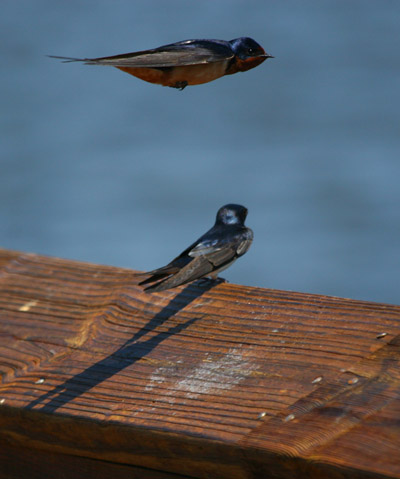 I couldn’t pass up posting this one, could I? They’d been sitting together just like you’ve seen, and one took flight and landed again repeatedly, not sure what to make of me being there. Like most birds, they’re reluctant to go straight to a nest and lure predators there, so they check the surroundings first, and I happened to capture a nice composition as I snapped away. I need to mention that this was with a newly-obtained Canon 100-300 f5.6 L lens, a surprising little gem not produced anymore, small enough to carry around easily, but much sharper than the current offerings of consumer lenses, and it performs quite well even given the slow noisy autofocus and archaic push-pull zoom. There are better lenses, but they’re bulky and quite expensive, while this one can remain in the bag for just about any situation. Canon really needs to restart production of it, preferably with a ring ultrasonic focusing motor, and just do away with their line of 75-300s.
I couldn’t pass up posting this one, could I? They’d been sitting together just like you’ve seen, and one took flight and landed again repeatedly, not sure what to make of me being there. Like most birds, they’re reluctant to go straight to a nest and lure predators there, so they check the surroundings first, and I happened to capture a nice composition as I snapped away. I need to mention that this was with a newly-obtained Canon 100-300 f5.6 L lens, a surprising little gem not produced anymore, small enough to carry around easily, but much sharper than the current offerings of consumer lenses, and it performs quite well even given the slow noisy autofocus and archaic push-pull zoom. There are better lenses, but they’re bulky and quite expensive, while this one can remain in the bag for just about any situation. Canon really needs to restart production of it, preferably with a ring ultrasonic focusing motor, and just do away with their line of 75-300s.
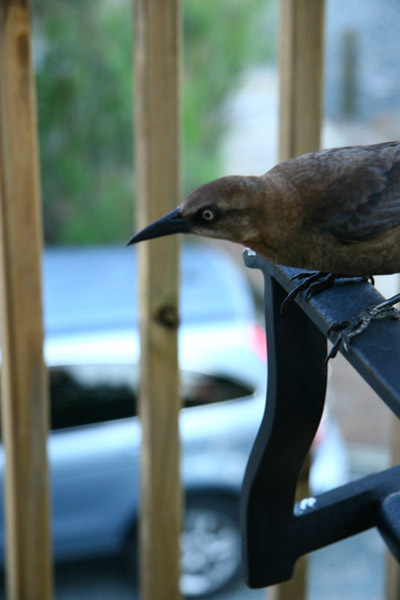 One of the species of which there was no shortage, and which we had a couple of memorable encounters, were the boat-tailed grackles (Quiscalus major.) They’re generally a coastal bird, but more because of marshes and wetlands where they nest, though this doesn’t stop them from checking out the beach if they think they can find something to eat there. On our first day, The Girlfriend’s Sprog had found a bit of coral that resembled a portion of a dog biscuit, and had left it sitting on her clothes while she was enjoying the ocean waves, and I watched a brazen female grackle land nearby, scurry purposefully up to the clothes pile, and snag the coral before immediately flying off – she’d done this kind of thievery before. I can’t vouch for how much frustration a bird might feel when it finds its valiantly-obtained meal is actually inedible, but the bird deserved it nonetheless. Two days later, The Girlfriend and I were sitting on the kitchen deck snacking on Doritos, and another female grackle, or perhaps even the same one, landed right next to us on the railing and sat eyeing the bag intently – it couldn’t have been clearer that she knew exactly what it was. I’m not the kind to encourage this kind of begging/scrounging, but The Girlfriend wanted to see just how daring the bird was, so I ended up putting a portion of a chip on my bare knee and just waited. The grackle needed no further urging, and with little hesitation worked along the rail, then over to the chair alongside me, up to the arm, and quickly hopped across to my knee to snatch the chip, consuming it only a meter away on the railing. She did this twice, until a male appeared making a fuss, which made her uneasy, while the appearance of the male set off a pair of mockingbirds that were apparently nesting nearby, who harassed them both until they flew off.
One of the species of which there was no shortage, and which we had a couple of memorable encounters, were the boat-tailed grackles (Quiscalus major.) They’re generally a coastal bird, but more because of marshes and wetlands where they nest, though this doesn’t stop them from checking out the beach if they think they can find something to eat there. On our first day, The Girlfriend’s Sprog had found a bit of coral that resembled a portion of a dog biscuit, and had left it sitting on her clothes while she was enjoying the ocean waves, and I watched a brazen female grackle land nearby, scurry purposefully up to the clothes pile, and snag the coral before immediately flying off – she’d done this kind of thievery before. I can’t vouch for how much frustration a bird might feel when it finds its valiantly-obtained meal is actually inedible, but the bird deserved it nonetheless. Two days later, The Girlfriend and I were sitting on the kitchen deck snacking on Doritos, and another female grackle, or perhaps even the same one, landed right next to us on the railing and sat eyeing the bag intently – it couldn’t have been clearer that she knew exactly what it was. I’m not the kind to encourage this kind of begging/scrounging, but The Girlfriend wanted to see just how daring the bird was, so I ended up putting a portion of a chip on my bare knee and just waited. The grackle needed no further urging, and with little hesitation worked along the rail, then over to the chair alongside me, up to the arm, and quickly hopped across to my knee to snatch the chip, consuming it only a meter away on the railing. She did this twice, until a male appeared making a fuss, which made her uneasy, while the appearance of the male set off a pair of mockingbirds that were apparently nesting nearby, who harassed them both until they flew off.
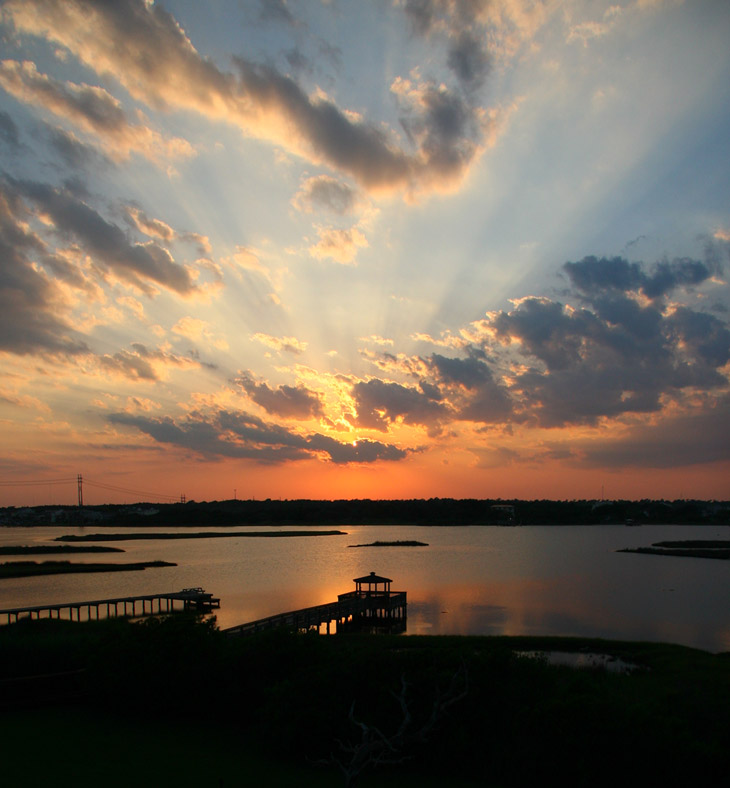
And so I close, for now (there’s a lot more coming) with sunset over the sound and intracoastal waterway, showing the very gazebo that we used – this was taken from the upper deck of the rental property, at 17mm so it looks a lot further off than it was. The scattered clouds, always a useful factor for cool sunset shots, were the product of warm days with moderately high humidity, and vanished by morning each day – like I said, we got lucky with the conditions of the trip. I’ve got a lot of images to sort through and catalog…




















































